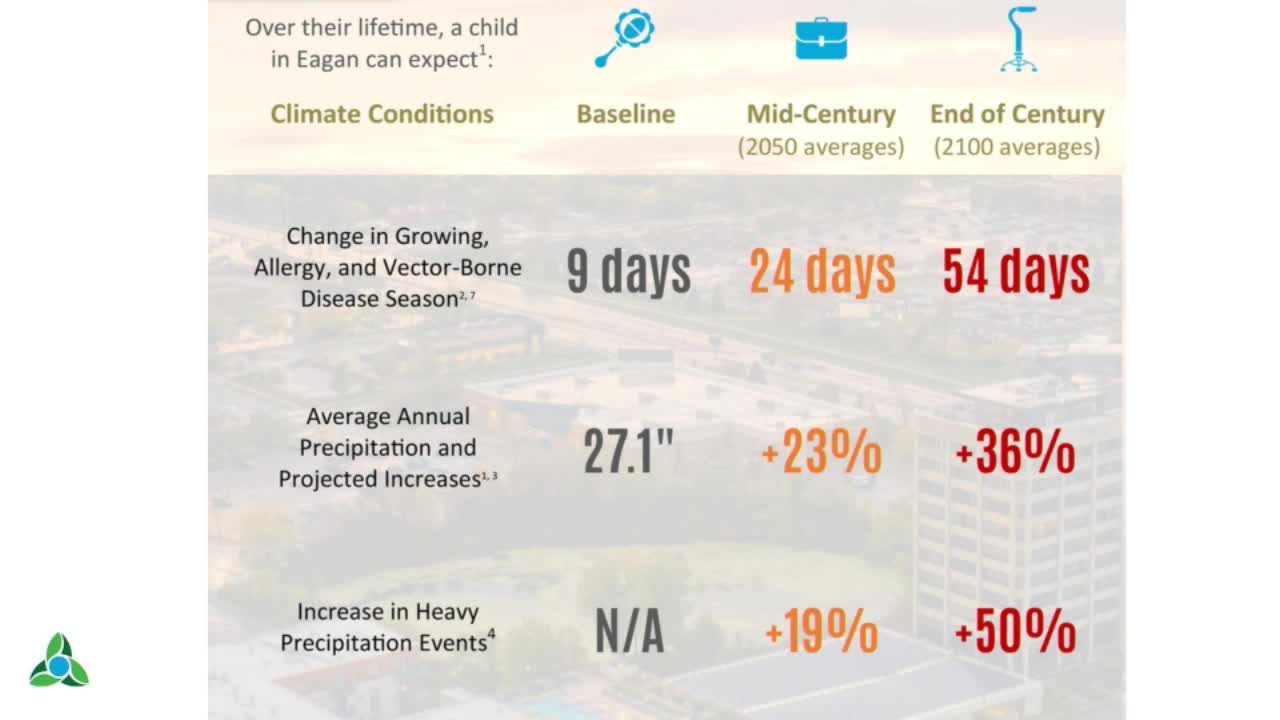Eagan braces for climate crisis with urgent action plan
October 08, 2024 | Eagan, Dakota County, Minnesota
This article was created by AI summarizing key points discussed. AI makes mistakes, so for full details and context, please refer to the video of the full meeting. Please report any errors so we can fix them. Report an error »

During a recent government meeting, officials discussed the pressing implications of climate change for the community of Eagan, highlighting significant increases in growing seasons, heavy precipitation, and the potential for extreme weather events. Projections indicate that by the year 2100, Eagan's summers could resemble those of Oklahoma or Northern Texas if current emissions trends continue.
The meeting underscored the risks associated with these climate projections, including extreme weather, food insecurity, and economic challenges such as rising energy costs. Officials emphasized the need to prioritize vulnerable populations, particularly older adults, economically stressed individuals, people of color, and at-risk workers, who may be more sensitive to climate impacts.
Eagan's greenhouse gas (GHG) inventory revealed a 15% reduction in emissions over the past decade, despite a 5% population increase and an 8% rise in GDP. This data suggests that emissions can be reduced even as the community grows economically. However, while projections indicate a continued decline in emissions, the pace is slower than desired. A recent state law mandating carbon-free electricity is expected to significantly contribute to these reductions, although challenges remain with fossil fuel consumption from natural gas and vehicles.
The discussions highlighted the importance of proactive climate planning and the need for targeted investments to address the vulnerabilities faced by Eagan's residents in the face of climate change.
The meeting underscored the risks associated with these climate projections, including extreme weather, food insecurity, and economic challenges such as rising energy costs. Officials emphasized the need to prioritize vulnerable populations, particularly older adults, economically stressed individuals, people of color, and at-risk workers, who may be more sensitive to climate impacts.
Eagan's greenhouse gas (GHG) inventory revealed a 15% reduction in emissions over the past decade, despite a 5% population increase and an 8% rise in GDP. This data suggests that emissions can be reduced even as the community grows economically. However, while projections indicate a continued decline in emissions, the pace is slower than desired. A recent state law mandating carbon-free electricity is expected to significantly contribute to these reductions, although challenges remain with fossil fuel consumption from natural gas and vehicles.
The discussions highlighted the importance of proactive climate planning and the need for targeted investments to address the vulnerabilities faced by Eagan's residents in the face of climate change.
View full meeting
This article is based on a recent meeting—watch the full video and explore the complete transcript for deeper insights into the discussion.
View full meeting
